#Chattanooga Choo Choo Hotel
Text
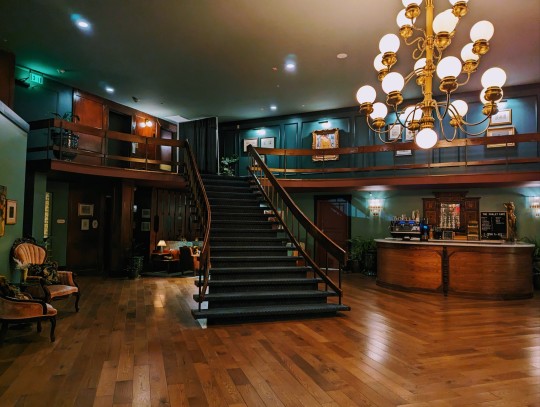

I love a hotel that's not afraid of COLOR. (especially dark ones)
#This is The Hotel Chalet at The Choo Choo#in Chattanooga TN#I got back home Wednesday night and I should have taken more photos#But I needed to get away and just exist for a while#Spend some time for me.#Ate a lot of good food#Spent a lot of time outdoors#And of course a day at my favorite aquarium#So no complaints at all
6 notes
·
View notes
Photo



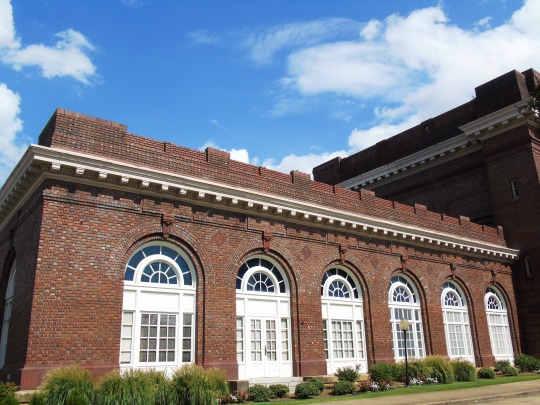



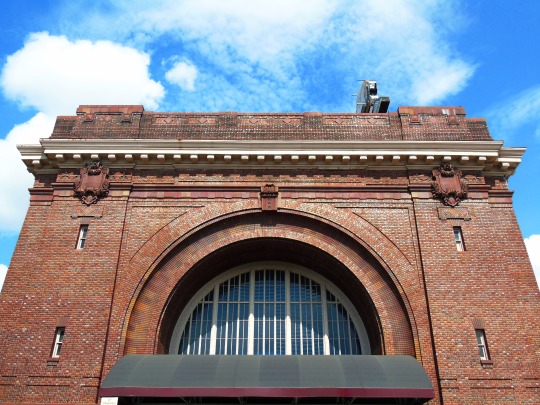


Clouds (No. 762)
Chattanooga, Tennessee
#Chattanooga#Chattanooga Choo Choo#Chattanooga Choo-Choo Hotel#USA#Tennessee#summer 2016#original photography#train#locomotive#travel#fountain#architecture#engineering#tourist attraction#landmark#vacation#old steam locomotive#Terminal Station#blue sky#clouds#cityscape#flora#flower
1 note
·
View note
Text
Lucifer 5x04 - The Mega Meta

This episode, the one all the cast and writers praised turned out to be the most challenging for the audience. Several hated it mainly for interrupting the flow of S5P1 whilst introducing a ‘weak’ story for Lucifer’s ring. Others loved it for all the meta, the concealed trivia and details that exist in that episode.
In my opinion 5x04 took it’s time to warm up to my heart and therefore today it’s time to write a meta on it. I’ll try to cover all the bases and if I miss something I apologise!
This meta will analyse, lines, settings, songs hopefully with the order they appear in the episode, as well as hints that it gives us for P2, the end of the series and many more things.
The credits open to Lucifer whistling as per Netflix’s subtitles ‘Chattanooga Choo Choo’
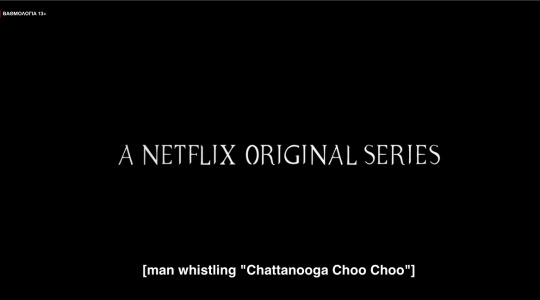
A song of about a man waiting for his train as he gets a shoe shine. The lyrics reveal at the end that a girl is waiting him at his destination and that he intents to marry her and settle... A good foreshadowing about Lucifer no? Especially after the S3 game night fiasco...
There's gonna be a certain party at the station
Satin and lace, I used to call funny face
She's gonna cry until I tell her that I'll never roam
By the way what’s this obsession over daggers and them killing people? Didn’t we have enough with the Flaming Sword in S2?

Trixie: Has it ever killed anyone?
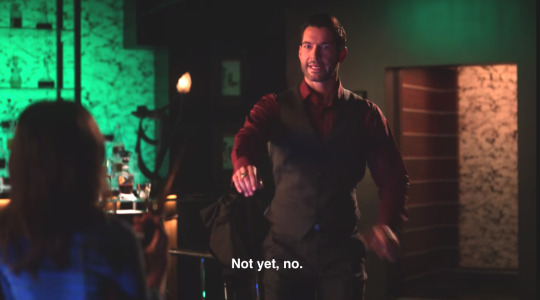
Let’s keep it that way kid... Although I doubt it.
Now take a moment to realise that Lucifer was in Hell for thousands of years. He hasn’t had sex since his relationship with Eve and for his last night on Earth he prefers to play a game of Monopoly with Trixie and only when she turns him down Lucifer suggests getting a drink at LUX always in her company. That’s progress...
It also busts all claims of Lucifer being a sex obsessed maniac.
The year is 1946...
WW2 is over and we find Lucifer in a new setting, a familiar one where through the episode we see that he has not just visited again but he is frequent visitor around that time. Just a few years later after all he was seen through Kinley’s photos in Nazi Germany. Now we know it was because apparently he owns a castle there, in the Austrian Alps... Not exactly in mint condition after the war though...
By the way the castle that corresponds to that 22 bedroom description Lucifer gives is Schloss Ernegg Castle which belongs to the same family since the 17th century and it’s in great condition. Actually it operates as a hotel!

The Hurry plays as we see Ellis strolling the WB New York area of the lot. Great old ones were shot there.. Like The Big Sleep (1946) staring Bogart and Bacall which was shot in 1944, reshot some parts in 1945 but was released after all the ‘proper’ war time movies were released first.
A bit like this episode The Big Sleep carries ‘process of a criminal investigation, not its results’. Also around that time we have The Killers coming out, The Killers is important to mention as aside from being based on a story by Hemingway who was in Cuba in 1946 not in New York as Lucifer claims, it was directed by Robert :. Siodmak made most of the Hollywood’s noir classics and was always faithful to the doomed attraction which would always resolve to a nihilistic conclusion... (Thank you wiki! :P)
The connection to Lucifer, between the lines and the off hand comments like Hemingway is that noir films were based on the German Expressionism in cinema, and one of the most prominent figure for the US was that one German director Robert Siodmak.
The purpose of the above information is in order to tell you that a black & whte effect and a crime story is not what makes a noir episode. The writers were faithful to the core of noir. Entrapment, flashbacks, narration. The tropes of murder, jealousy, backstabbing and crime is also there, easy to replicate after all for sure. A dead man walking and ‘selective’ amnesia is also convenient...
Triumph and tragedy can be found and lost in the maze of the cities and in questionable establishments... Like in bars...
Moving on!
The credits open and we listen to The Hurry Up played by The Heath And His Orchestra. Dear Heath was British not an American. A subtle nod to Ellis probably as the leading man. But here is the thing Heath was the performer not the composer of that piece. The composer was Kenny Graham (Again British) and probably that piece was written after 1958 but anyways it’s an inconsistency we (-I-) can certainly live with!
Lucifer and Lilith last meeting was at around 1770 (Marie Antoinette was born in 1755) now whether in Austria or France who knows.... I would assume that Lucifer stayed in Austria until WW2 as aside from the wars and other issues it had a great cultural field for him to explore such as literature, music and lacked the brashness of the new-founded then US (1776).
Tiny issue here... Moctezuma (The 2nd) who Lilith claims to have met died in 1520, a bit after Cortés arrived in what we know today as Mexico so we can assume that Lilith travelled between the New World and Europe until Lucifer found her in New York in 1946.
Lilith in a relationship with Tommy Stomponato who owned the club, she probably influenced him enough to name it ‘The Garden’ as se admits to Gertie later in the episode, she really loved that Garden hence why she took a small part of it with her.
Now the name Tommy Stomponato is directly influenced by Johnny Stomponato part and bodyguard of the Cohen Mafia boss Mickey Cohen. Now funny thing he was stabbed by Lana Turner’s (Hollywood star) daughter Cheryl Crane... That remind us a bit of Gertie as she yes both were stabbed by a woman but both were not prosecuted. The first as Lilith didn’t want Gertie to lose the limited time she had with her husband and Cheryl because she claimed self-defense.
The first time we see Lesley Ann as Lilith she sings ‘I want to be evil’ originally performed at the debut of Eartha Kitt and first released in 1953. It is considered brilliant for it’s feminism and ‘video clip’ starring Kitt...
youtube
It’s a song that carries Lilith’s agony which even Eve carried. The need for freedom, the need to break the chains of what they should be and what we see that even Maze carries throughout the series. It’s a song that reaffirms that betrayal towards God, Adam and Lucifer in Maze’s case is not an act of evilness but the need of these women to re-sculpture themselves without aid or instructions. In Kitt’s case it was social conformity. Also Johnnie Ray was the ‘guy who cries’ aside from his hit song in 1951 ‘Cry’ him crying after his wedding was received with mixed feelings I believe from the press and his fans.
Now we see that crime for Lucifer was fun and again he wanted to Laugh with Hemingway who again in 1946 was not in New York but had just starting to write his novel ‘Garden of Eden (published posthumously in 1986) and it explored the reversal of gender roles a bit like this Lucifer episode does.
So Lucifer accepts the case of finding the ring but needs help. Jack Monroe is the one that can help him and the name is inspired probably by Iowa’s born Jack Monroe Marvel character who lived in New York, fought the Nazi (See Jack talking about the Battle of the Bulge), sidekick to Captain America - in a way - and ended up shot and killed. The character had many cliche detective phrases. But that’s mostly a likely speculation :P
Now as Jack goes to talk to the ‘rat’ Lucifer comments on Gertie serving him a drink ‘Just what the doctor ordered’ an obvious connection to Harris playing Dr Linda.
A nice prop is the machine gun over the bar an alleged gift from Al Capone who had been arrested 17 years earlier and died in 1947.
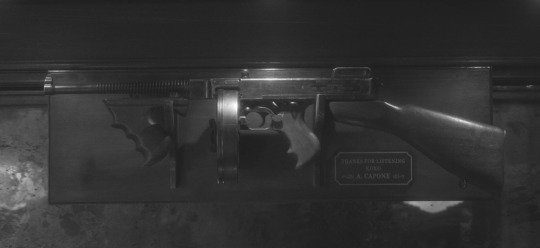
Thanks for listening, XOXO A. Capone
Now Lucky Larry who ends up dead is wearing an eyepatch probably a nod to another great director of noir films and of german expressionism in cinematography Fritz Lang.
At that point we have the talk between Lucifer and Jack concerning the laters problem with his wife. The story as everyone has noticed is a parallel with the issue that Lucifer and Chloe never begun on an equal ground. Someone had manipulated them and in both cases both parties suffered. Both men were manipulated by someone over them in hierarchy and both stood on a dilemma on how to proceed. It took Lucifer over 60 years to realise how difficult it was to leave and even then in 2x14 he returned.
As Jack and Lucifer get to Willy’s mansion all the paintings depict him as a great warrior in all possible eras. As Napoleon, Fritz of Austro-Hungarian Empire, Henry the 8th, Ivan, and that armour I believe it was from Carlomagne?
Also Hannibal crossing the Alps?
The little sausages are self-explenatory for the character and perhaps the lilies in his house a connection to the episode and the P1′s plot.

Lucifer checking the armour’s genital protector? Priceless :P As was Willy’s connection to Dan.
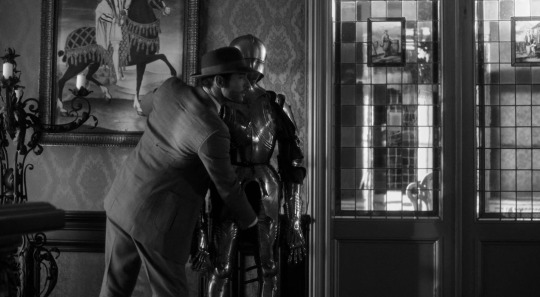
Now something that always make me wonder is why Lilith calls God Adam’s father as if she never considered him her own. At the same time she gives us a big hint there. She never walked away she was ‘sent’ away.
Gertie reveals there that her husband was wounded at the Guadalcanal campaign which ended in 1943 meaning that Bill was unresponsive for about three years at that point. The good news is that Bill seems to have been inspired by Bill Lentsch. Lentsch wrote a memoir called My Story and then adapted under the Title Hope For Wounded Warriors.
As a wounded warrior, Bill Lentsch knows the frustrating feelings of apparent helplessness and hopelessness. A sea-going Marine on the cruiser USS Vincennes at the beginning of World War II, he was a "hot shell catcher". The story of Bill's survival when the Vincennes sank is a story of miracles. In contrast, the story of his post-war rehabilitation and readjustment to civilian life, including a bad marriage {Sanoiro: At this point we have a differentiation but you never know}, contains more than its share of dark pages and the consequences of poor choices. Contemplating the option of murder, then suicide, was a vivid reality. Thankfully, the story of his later years brings hope and inspiration as Bill shares his personal journey of discovery.
Meanwhile the investigation continues. In the apartment we see pigeon cages a rather popular hobby back then in New York and not just for the messages they transported. Also do notice the WB water tower in the back. Iconic!
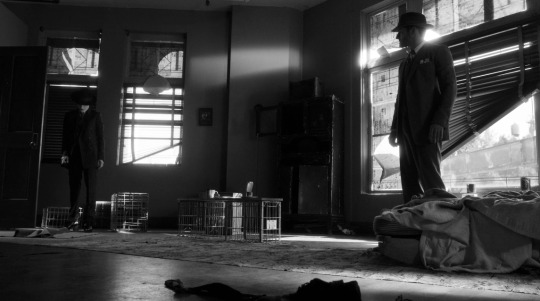
Lucifer finds a cuban cigar. Romeo y Juliet. The meta here obvious bit nonetheless important to our main love story.

With Stomponato dead we have a chance to delve a bit to Egyptian mythology.

First the missing heart. The main organ that according to ancient Egyptians held the answer of how well you had done while you lived and what you deserved after death. It was measured and a conclusion sent you to afterlife or to damnation.
Second the Anubis mask. He was the God of Death who oversaw the heart weighting process. The colour black symbolised the Nile’s sand and thus regeneration as the river was a symbol of life. Anubis was adopted by Isis
Third the Eye of Horus. The Eye of Horus was used as a sign of prosperity and protection, derived from the myth of Isis and Osiris. This symbol has an astonishing connection between neuroanatomical structure and function.
That’s the basics but you can go further from there if you want to just remember that Egyptian deities hold an Ankh the symbol and work of life.
In 504 we learn that death is final, there is no eternal life. It cannot be given as a commodity, the ring cannot help so I would focus more on the stone itself and if Lilith’s immortality is used then it will not be used as it is in my opinion but more about that later on.
The shop sacred eye and the high priest take us back to two episodes of S1. First in 1x07 - Wingman where the high priest parallels the auctioner who was ready to sell everything of ‘supernatural’ worth knowing they were mostly garbage to make money. Second 1x12 - #TeamLucifer the satanic high priest who had said ‘-the Devil ain't gonna buy me an Aston Martin’. In 504 the High Priest wanted a Pontiac.
Lucifer comment on Tutankhamun loving the pre-sacrificed bloody heart might have to do with the Egyptian mythology that If a heart during the scaling was judged to be not pure, Ammit (female demon/god) would devour it, and the person undergoing judgment would not allowed to continue their afterlife journey.
One of the best lines delivered in this episode is also foreshadowing P2 in my opinion and why not some bts but not clear or definite ones.
In the modern age, we are taught to fear death. But the ancients understood that death... is power. - High Priest (Lucifer 5x04)
It is why I always say that death is not the last frontier in our series and as such it should be taken neither as the final chapter to an individual’s story nor as irreversible (with the right collaterals always) somehow. Although you cannot cheat death forever, this is the beauty of our story. Death is valued just as much as life.
As such as we are in the High Priest ‘office’ it is not accidental we see the Tree of Life (See my Tree of Life Meta *Here*). The designs are Celtic around the mirroring tree of Life in what we can assume is in Life and Death is as vibrant and ‘alive’ in both sides.

1) triskelion: meaning the three legs, is an ancient pre-celtic symbol that can be traced to the bronze era. It symbolises the holy trinity in Christianism but also the inner and outer world of spirits. As you can tell it holds a variety of meanings and even if it is just there, picked in random from the WB prop house we should note that it also symbolises the trinity of life, death and rebirth as well as the trinity of the transition of womanhood. The Triple Goddess: maiden, mother and the (older?) wise woman.
For this meta we will take the trinity of life, death and rebirth as well as elevate it to the transition of our lead characters. Chloe as a young woman, a mother and now a ‘wise’ older and more mature woman. Lucifer as the young rebel, a struggling with maturity and responsibility man and what he may become by the end of S5 without shedding any of his prior roles and identities. Only this time his identities no longer ‘stain’ him.
2) Knotted symbol - Eternal knot: We see them in many cultures and religions in Buddhism they represent birth, death and rebirth. In the inside we see Solmon’s Knot a symbol of immortality and eternity but some also parallel it to Lover’s Knot (See True Lover’s Knot), an ancient symbol of commitment and love. From this keep the eternal part of the symbolism which is often depicted in jewish cemeteries.
3) Celtic Cross: They are said to be based on some cases to the Egyptian Ankh (See Coptic Crosses), some also allege the design in the combination of the Christian cross and the pagan sun disk.
4) The Celtic Tree of Life: For this I take what is written in this site
The tree represents rebirth. Trees were said to guard the land and acted as a doorway into the spirit world.
The Tree of Life connects the lower and upper worlds as its roots grow far down while its branches reach high. The tree trunk connects both of these worlds to the Earth’s plane. It was with this connection of worlds, that it was said that people are able communicate with the gods in the heavens using the Tree of Life.
Tree of Life knots symbolize the branches and roots of a tree which are woven together with no end to show how the cycle of life is continuous.
Through the second part of the episode I was always looking at Lucifer’s tie. I might be wrong but it reminded me a lot of gears, with a heart and clocks on it. Essentially the clock is ticking... in more ways that one as well as for Lilith but give me some more lines before I return to this meta point.
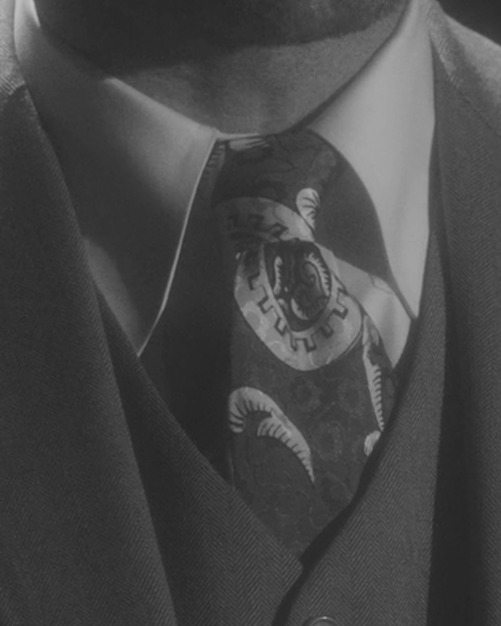
As Lucifer asks how humans believe her ring makes her immortal she ends her story with the line:
“I survive, and... somebody writes it on a stone tablet. You know how these things start.”
For me that was always a direct reference to the Favourite Son deal we had with the book in episode 2x17. As Lucifer said in 2x18 when Chloe asked whether his Dad said that Amenadiel was His favourite, Lucifer replies:
In so many Sumerian words.
Later on in S3 (3x14) Lucifer tells to Cain that Amenadiel is the favourite when he asks him as:
But the quick version: a book said it, so it must be true.
To be honest this re-occurring mentioning makes me hold to my belief that something was translated wrong there...
As the 5x04 sceheme to get the ring back is underway Lilith looks at Jack & Shirley’s interaction which is interesting not because it’s when Lilith starts to perhaps thinking of retiring her immortality but because a very special question comes to mind.
Michael knew the ring’s story. He claimed that he was the one who manipulated Lucifer into having his vacation, but his vacation just ‘happened’ to be at the same time Chloe was on Earth?
Here is a speculative meta.
Lilith asks Lucifer if he ever connected with anyone emotionally to which he replies:
Absolutely not. It would take a literal miracle for me to want something like that, and I'm fairly certain my father's not handing those out anymore.
It makes you wonder whether Michael was around listening, planning carefully his next moves. That that’s how he knew the ring’s story, or how he may have plotted Chloe’s miraculous birth by manipulating God.
At this point everything is possible but we should never forget that God at that point is still powerful and omniscience so Michael might be only alf of the explanation why Chloe is on Earth as a key for Michael to take down his brother and materialise his other plans. The other half is only known by God but will he be willing to share in P2 or even in S6 if he appears there?
Lesley-Ann as Lilith starts to sing ‘Someone to Watch Over Me’ a song written over the songwritter’s (Ira Gershwin) wedding anniversary, a true love song on many levels written in 1926 and featured in the Brodway Musical ‘Hey, Kay!’.
The musical’s plot is about an engaged womaniser falls in love with Kay and the song after lots of thought was placed to reveal to the audience of Kay’s realising that she is in love with the male lead, womaniser Jimmy.
We will never perhaps know if by imminence to Lilith’s first song lyrics, Lilith to a point was in love with Lucifer and held on to hope until she surrendered everything for a normal life not wanting to wait for the impossible. Of course that’s just one interpretation not a hard conviction of mine.
An analysis of the song writes:
When first composing this piece, the Gershwin brothers tried to capture the feeling of safety (and love) that everybody longs to have. The addition of the doll (a doll was added as the listener of the song in the rehearsals and stayed in the show) only enhanced the childlike, vulnerable side of the song that was being hinted at in lyrics such as, “I’m a little lamb who’s lost in the woods.”
Although many artists sing this like a love song, its first performance, directed at a doll, gave the piece an aura of safety not usually present in romantic songs.
Perhaps that safety should be also attributed here. Lilith still has her safety still holding on to her immortality knowing though that she will surrender it. Lucifer is unaware he one day will surrender his willingly because he fell in love.
In the end they both carry the vulnerability of needing someone to understand and love them. No matter how cynical we find both Lilith and Lucifer with his brutal Caligula orgy comments, they both crave about someone. Both have lost hope to their Shepard aka God/Dad.
Perhaps I’m wrong on my first impression with Lilith and her affection towards Lucifer. Perhaps they both are the prodigal children, lost in the woods wishing for someone to finally take care of them but no longer hoping for one, until Lilith takes the leap. Lucifer will need almost 80 more years and Chloe Decker to let someone take care of him.
Perhaps that’s why they do a duet on the lyrics:
Someone who'll watch over me
I'm a little lamb who's lost in the wood
I know I could, always be good
To one who'll watch over me
And the case is back to move the episode forward and enter the present Lucifer Trixie interlude and ‘Forget it Trix. It’s Chinatown!’
That line was the most obvious one as it comes from the more recent noir movie with Bogart and Chinatown (1974). In the movie aside from the mystery plot Evelyn - the mother eventually dies, the twist is that of an abuse which led to her daughter/sister’s birth and although that does not fit our serie’s plot the death of the main lady might. All a speculation so do not be dishearten remember all the above and this is not an S&S it’s a meta :P
After all Lucifer’s line goes back to the complex dealings in Chinatown and how understanding something fully is not always feasible.
Interesting is also how Lucifer shots, albeit the foot not the leg, of willy to prove Willy is not immortal. Like Chloe did to him in 1x04 and to Michael in 5x02. Jewelry is not going to save anyone. Big words but you know me. I believe in other provisions or actions even if they include the ring.
We all die, Lily. And that's okay. Truth is... I'd rather die today trying to save the man I love... than live forever without him.
The past, the present and perhaps the future?
The case is resolved and Jack follows Shirley to Des Moines (Capital of Iowa). That’s an inner joke as Joe Henderson is from Iowa and graduated from the University of Iowa.
Before Jack follows her remember that Shirley had asked more from him when he told her to be careful. A bit like Chloe in the evidence room in 5x08. If some have watched unconditional love then you might remember the scene where Kathy Bates tells to her husband played by Dan Aykroyd that him telling her ‘I love you was never a condition but at that point it now was. Similar to what we saw Chloe asking from Lucifer. A foreshadowing perhaps that eventually Lucifer will follow Chloe.
Now two things. Lucifer in episode 504 prepares their game night. He is now comfortable and even enjoying their game nights, he find himself right where he wants to be without being fearful of being dull. He is a shoe and that’s fine.
When Trixie asks Lucifer whether Jack and Shirley had a happy ending he tells her probably not as they moved to Des Moines meaning it was a boring move between New York and Iowa in general. Iowa and Des Moines have been used several times in jokes by the way due to Henderson.
Now back to Lucifer, at that point he does not see that sometimes sacrifices that lead to ‘boring’ lives are the best outcome and happiness is not equal to excitement but he is a slowly maturing Devil...
That part can help us to analyse the end of the story from 1946.
Lucifer says: Once you do this, there's no going back.
This implies that whether you surrender your immortality or gain it -for the second I’m quite doubtful it can be done on the same terms - it is forever. No going back.
Lilith’s next words reveal a broken woman who gets her Hail Mary and hopes for the best. As a parent she offered her children the best place to never realise they are lacking but Lucifer by bringing Maze to earth undid that as Maze slowly reaches her potential, learning there is a different way. God’s words echo since 3x26.
So was Lucifer a kindergarten guardian for Lilith? In a way yes but Lucifer in 5x04 understood Lilith’s logic. In their distorted image of how you can break an individual, the Lilims seemed safe from Lucifer’s and Lilith’s fates. Cast out, punished, unloved, lonely and in an unspoken despair to connect but too afraid to try again until Lilith tried again. The end of 504 showed she didn’t succeed o find what she was looking for. We have no way of knowing if we will see her again in P2 but it’s probable.
Lilith kisses Lucifer goodbye, making me once again wonder if a part of her did had feelings for him and wishes him back to enjoy the rest of his life as if somehow she knew, although she couldn’t.
The story ends here and perhaps the clock starts ticking for Lucifer through Michael. Perhaps the planning started with Penelope and John that were meant to be born, get married but not have children and then Chloe came along. But that’s just a theory...
And before the screen fades to dark, Lilith walks away with Lucifer standing in the middle of the street and we listen to ‘This Is Ours’ by Peter Sivo’s Band (1946-1961).
This is Ours lyrics are the words of a man which mystify me. For me it is a song that gives us a couple together after a very long time that reconnects. It was a meant to be couple but the past had to happen. He had to get married, for both of them to live apart their own lives until one day they get back together and now they can be together. There is no sadness, there is relief, contentment.
Several say that How I Met Your Mother had an awful ending. If you have not watched it and want to please stop here but know that I believe that the ending was just right.
In How I Met Your Mother, the lead (father) marries the mother of his children but it is revealed that she eventually dies and some years later he starts telling them a story that lasts ten years as all aspects of it in his belief is about how he met their mother. His daughter interrupts him saying that no it’s about how he met the woman he wants to be together now. They all know that the Mother was loved and was the One but in this life there is more, there are second chances because life happens and it’s not a bad thing and the time in between is as joyful as the future despite of the tragedies in between.
So a part of me wonders if Deckerstar will go a bit through that to a point.
Forget the past, for this is ours...
The thing is that a bittersweet ending gives as a possibility and then we are left wondering past that.
Trixie: I bet Jack and Shirley talked the whole bus ride and fixed everything.
Lucifer: Yes. Yes, perhaps they did.
After all they did move to Des Moines... After that we can only guess.
21 notes
·
View notes
Text
Willie Mays

Willie Howard Mays Jr. (born May 6, 1931), nicknamed "The Say Hey Kid", is an American former professional baseball center fielder, who spent almost all of his 22-season Major League Baseball (MLB) career playing for the New York/San Francisco Giants, before finishing with the New York Mets. He is regarded as one of the greatest baseball players of all time and was elected to the Baseball Hall of Fame in 1979.
Mays won two National League (NL) Most Valuable Player (MVP) awards, ended his career with 660 home runs—third at the time of his retirement and currently fifth all-time—and won a record-tying 12 Gold Glove awards beginning in 1957, when the award was introduced.
Mays shares the record of most All-Star Games played with 24, with Hank Aaron and Stan Musial. In appreciation of his All-Star record, Ted Williams said "They invented the All-Star Game for Willie Mays."
Mays' career statistics and his longevity in the pre-performance-enhancing drugs era have drawn speculation that he may be the finest five-tool player ever, and many surveys and expert analyses, which have examined Mays' relative performance, have led to a growing opinion that Mays was possibly the greatest all-around offensive baseball player of all time. In 1999, Mays placed second on The Sporting News's "List of the 100 Greatest Baseball Players", making him the highest-ranking living player. Later that year, he was also elected to the Major League Baseball All-Century Team. Mays is one of five National League players to have had eight consecutive 100-RBI seasons, along with Mel Ott, Sammy Sosa, Chipper Jones, and Albert Pujols. Mays hit over 50 home runs in 1955 and 1965, representing the longest time span between 50-plus home run seasons for any player in Major League Baseball history. His final Major League Baseball appearance came on October 16 during Game 3 of the 1973 World Series.
Early life
Mays was born in 1931 in Westfield, Alabama, a former primarily black company town near Fairfield. His father, Cat Mays, was a talented baseball player with the Negro team for the local iron plant. His mother, Annie Satterwhite, was a gifted basketball and track star in high school. His parents never married and separated when Mays was three. Mays was raised by his father growing up. His father worked as a railway porter when Mays was born, but he later got a job at the steel mills in Westfield so he could be closer to home. When two girls in Mays's neighborhood were orphaned, his father took them in. Sarah and Ernestine helped raise young Willie, who always saw these two as his aunts. His father exposed him to baseball at an early age, playing catch with his son by the time Willie was five. At age 10, Mays was allowed to sit on the bench of his father's games in the Birmingham Industrial League, which Mays remembered as attracting six thousand fans per game at times.
Mays played multiple sports at Fairfield Industrial High School, averaging a then-record 17 points a game in basketball and more than 40 yards a punt in football, while also playing quarterback. Since he started playing professional baseball while still in high school, he quit playing high school sports when he was 16. Mays graduated from Fairfield in 1950.
Professional baseball
Negro leagues
Mays' professional baseball career began in 1947, while he was still in high school; he played briefly with the Chattanooga Choo-Choos in Tennessee during the summer. Later that year, Mays joined the Birmingham Black Barons of the Negro American League. He had first caught the eye of Barons' manager Piper Davis in tenth grade, when Davis had Mays try out for the team. Davis encouraged Mays to work on hitting the curveball, coached him periodically for a couple years, and gave Mays a chance to play for the Barons starting in 1947, when Mays was just 16. When E. T. Oliver, principal at Mays's high school, threatened to suspend Mays for playing professional ball, Davis and Mays's father convinced him that Mays would still be able to concentrate on his studies. Mays helped Birmingham win the pennant and advance to the 1948 Negro League World Series, which they lost 4-1 to the Homestead Grays. Mays hit a respectable .262 for the season, but it was also his excellent fielding and baserunning that made him a standout.
Over the next several years, a number of major league baseball franchises sent scouts to watch him play. The first was the Boston Braves. The scout who discovered him, Bud Maughn, had been following him for over a year and referred him to the Braves, who then packaged a deal that called for $7,500 down and $7,500 in 30 days. They also planned to give Mays $6,000. The obstacle in the deal was that Tom Hayes, owner of the Birmingham Black Barons, wanted to keep Mays for the balance of the season. Had the team been able to act more quickly, the Braves franchise might have had both Mays and Hank Aaron in their outfield from 1954 to 1973. The Brooklyn Dodgers also scouted him and wanted Ray Blades to negotiate a deal, but they were too late. The New York Giants had already signed Mays for $4,000 and assigned him to their Class-B affiliate in Trenton, New Jersey.
Minor leagues
According to Mays, Eddie Montague had been sent to Birmingham to scout Alonzo Perry as a potential first baseman for the Sioux City Soos of the Class-A Western League, but Montague became interested in Mays instead after watching a doubleheader. Due to a scandal in Sioux City concerning a Native American's burial in a whites-only cemetery at the time, Sioux City decided not to take Mays, and he was assigned to the Trenton Giants of the Interstate League instead.
After Mays batted .353 in Trenton, he began the 1951 season with the class AAA Minneapolis Millers of the American Association. During his short time span in Minneapolis, Mays played with two other future Hall of Famers: Hoyt Wilhelm and Ray Dandridge. Batting .477 in 35 games and playing excellent defense, Mays was called up to the Giants on May 24, 1951. Mays was at a movie theater in Sioux City, Iowa, when he found out he was being called up. A message flashed up on the screen that said: "WILLIE MAYS CALL YOUR HOTEL." He appeared in his first major league game the next day in Philadelphia. Mays moved to Harlem, New York, where his mentor was a New York State Boxing Commission official and former Harlem Rens basketball legend "Strangler" Frank Forbes.
Major leaguesNew York Giants (1951–1957)
Mays began his major league career on a sour note, with no hits in his first 12 at bats. On his 13th at-bat, however, he hit a towering home-run up and over the left field roof of the Polo Grounds off future Hall of Famer Warren Spahn. Spahn later joked, "I'll never forgive myself. We might have gotten rid of Willie forever if I'd only struck him out." Mays' batting average improved steadily throughout the rest of the season. Although his .274 average, 68 RBI and 20 homers (in 121 games) were among the lowest of his career, he still won the 1951 Rookie of the Year Award. During the Giants' comeback in August and September 1951 to tie the Dodgers in the pennant race, Mays' fielding and strong throwing arm were instrumental to several important Giants victories. Mays was in the on-deck circle when Bobby Thomson hit the Shot Heard 'Round the World against Ralph Branca and the Brooklyn Dodgers to win the three-game playoff 2-1 after the teams were tied at the end of the regular season.
The Giants went on to meet the New York Yankees in the 1951 World Series. In Game 1, Mays, Hank Thompson and Hall of Famer Monte Irvin comprised the first all-African-American outfield in major league history four years after the color line was broken. Mays hit poorly while the Giants lost the series 4–2. The six-game set was the only time that Mays and retiring Yankee slugger Joe DiMaggio (Mays's boyhood hero) would compete against each other.
U.S. Army (1952–53)
The United States Army drafted Mays in 1952 during the Korean War (1950–53) and he subsequently missed most of that season and all of the 1953 season. Mays spent much of his time in the Army playing baseball at Fort Eustis, Virginia. It was at Fort Eustis that Mays learned the basket catch from a fellow Fort Eustis outfielder, Al Fortunato. Mays missed about 266 games due to military service.
1954-57
In 1954, Mays returned to the Giants and hit for a league-leading .345 batting average while slugging 41 home runs en route to his only World Series championship. Mays won the National League Most Valuable Player Award and the Hickok Belt as top professional athlete of the year. He also became the first player in history to hit 30 home runs before the All-Star Game and was selected as an All-Star for the first of 19 consecutive seasons (20 total). Mays had 38 through July 28, but around that time, manager Leo Durocher asked him to stop swinging for home runs, explaining that the team wanted him to reach base more so run producers like Monte Irvin, Dusty Rhodes, or Hank Thompson could try to drive him home. Mays only hit five home runs after July 8 but upped his batting average from .326 to .345 to win the batting title, becoming the first Giant to lead the league in average since Bill Terry hit .401 in 1930. The Giants won the National League pennant and the 1954 World Series, sweeping the Cleveland Indians in four games. The 1954 series is perhaps best remembered for "The Catch", an over-the-shoulder running grab by Mays in deep center field of the Polo Grounds of a long drive off the bat of Vic Wertz during the eighth inning of Game 1. Considered the iconic image of Mays' playing career and one of baseball's most memorable fielding plays, the catch prevented two Indian runners from scoring, preserving a tie game. Mays said he realized as he ran that he was going to have to make a running catch, which is why he did not turn to look at it until the ball was almost at the wall. The Giants won the game in the 10th inning on a three-run home run by Dusty Rhodes, with Mays scoring the winning run. The 1954 World Series was the team's last championship while based in New York. The next time the franchise won was 56 years later when the San Francisco Giants won the World Series in 2010.
Mays went on to perform at a high level each of the last three years the Giants were in New York. In the middle of May, 1955, Durocher asked him to try for more home runs. Mays led the league with 51. In 1956, he hit 36 homers and stole 40 bases, being only the second player, and first National League player, to join the "30–30 club". In 1957, the first season the Gold Glove award was presented, he won the first of 12 consecutive Gold Glove Awards. At the same time, Mays continued to finish in the National League's top-five in a variety of offensive categories. Mays, Roberto Clemente (also with 12), Al Kaline, Andruw Jones, Ken Griffey, Jr. and Ichiro Suzuki are the only outfielders to have ten or more career Gold Gloves. In 1957, Mays became the fourth player in major league history to join the 20–20–20 club (2B, 3B, HR), something no player had accomplished since 1941. Mays also stole 38 bases that year, making him the second player in baseball history (after Frank Schulte in 1911) to reach 20 in each of those four categories (doubles, triples, homers, steals) in the same season.
San Francisco Giants (1958–1972)
After the 1957 season, the Giants franchise relocated to San Francisco, California. Mays bought two homes in San Francisco, then lived in nearby Atherton. Manager Bill Rigney wanted him to challenge Babe Ruth's single-season home run record that year and did not play Mays much in spring training in hopes of using his best hitter every day in 1958. As he had in 1954, Mays vied for the National League batting title in 1958 until the final game of the season. Moved to the leadoff slot the last day to increase his at bats, Mays collected three hits in the game to finish with a career-high .347, but Philadelphia Phillies' Richie Ashburn won the title with a .350 batting average. Mays did manage to share the inaugural NL Player of the Month award with Stan Musial in May (no such award was given out in April until 1969), batting .405 with 12 HR and 29 RBI; he won a second such award in September (.434, 4 HR, 18 RBIs). He played all but two games for the Giants, but his 29 home runs were his lowest total since returning from the military.
Owner Horace Stoneham made Mays the highest-paid player in baseball with a $75,000 contract for 1959; Mays would be the highest-paid player through the 1972 season, with the exceptions of 1962 (when he and Mickey Mantle tied at $90,000) and 1966 (when Sandy Koufax received more in his final season). Mays had his first serious injury in 1959, a collision with Sammy White in spring training that resulted in 35 stitches in his leg and two weeks of exhibition ball missed; however, he was ready for the start of the season. During a series against the Reds in August, Mays also broke a finger but kept it a secret from other teams in order to keep opposing pitchers from throwing at it. In 1959, the Giants led by two games with only eight games to play, but won just two of their remaining games and finished fourth, as their pitching staff collapsed due to overwork of their top hurlers. The Dodgers won the pennant following a playoff with the Milwaukee Braves. As he did in New York, Mays would "play around" with kids playing sandlot ball in San Francisco. On three occasions in 1959 or 1960, he visited Julius Kahn Playground, five blocks from where he lived, including one time Giant players Jim Davenport and Tom Haller.
Alvin Dark was hired to manage the Giants before the start of the 1961 season and named Mays team captain. The improving Giants finished 1961 in third place and won 85 games, more than any of the previous six campaigns. Mays had one of his best games on April 30, 1961, hitting four home runs and driving in eight runs in a 14–4 win against the Milwaukee Braves at County Stadium. Mays went 4-for-5 at the plate and was on deck for a chance to hit a record fifth home run when the Giants' half of the ninth inning ended. Mays is the only Major Leaguer to have both three triples in a game and four home runs in a game. According to Mays, the four-homer game came after a night in which he got sick eating spareribs; Mays was not even sure he would play the next day until batting practice.
Mays led the team in eight offensive categories in 1962. He hit a game-winning home run in the eighth inning against Turk Farrell of the Houston Colt .45's in the Giants' final regularly-scheduled game of the year September 30, forcing the team into a tie for first place with the Los Angeles Dodgers. The Giants went on to win a three-game playoff series against the Dodgers, advancing to play in the World Series. The Giants lost to the Yankees in seven games, and Mays batted .250 with two extra-base hits. It was his last World Series appearance as a member of the Giants.
Before the 1963 season, Mays signed a contract worth a record-setting $105,000 per season (equivalent to $876,864 in 2019) in the same offseason during which Mickey Mantle signed a deal for what would have been a record-tying $100,000 per season.
In the 1963 and 1964 seasons Mays batted in over 100 runs and hit 85 total home runs. On July 2, 1963, Mays played in a game when future Hall of Fame members Warren Spahn and Juan Marichal each threw 15 scoreless innings. In the bottom of the 16th inning, Mays hit a home run off Spahn for a 1–0 Giants victory. He won his third NL Player of the Month Award in August (.387, 8 HR, 27 RBI). Normally the third hitter in the lineup, Mays was moved to fourth in the lineup in 1964 before returning to third in subsequent years. Mays took part in another long game May 31, 1964, when, after playing all nine innings of the first Game of a doubleheader against the New York Mets, he played all 23 innings of the Giants' 8-6 victory in Game 2. He was moved to shortstop for three innings of the game and grew so tired over the course of it that he used a 31-ounce bat (four ounces smaller than his standard) for his final at bat, in the 23rd inning.
A torn shoulder muscle sustained in a game against Atlanta impaired Mays's ability to throw in 1965. He compensated for this by keeping the injury a secret from opposing players, making two or three practice throws before games to discourage players from running on him. Mays won his second MVP award in 1965 behind a career-high 52 home runs. On August 22, 1965, Mays and Sandy Koufax acted as peacemakers during a 14-minute brawl between the Giants and Dodgers after San Francisco pitcher Juan Marichal had bloodied Dodgers catcher John Roseboro with a bat. Mays grabbed Roseboro by the waist and helped him off the field, then tackled Lou Johnson to keep him from attacking an umpire. Johnson kicked him in the head and nearly knocked him out. After the brawl, Mays hit a game-winning three-run home run against the Koufax, but he did not finish the game, feeling dizzy after the home run. Mays also won his fourth and final NL Player of the Month award in August (.363, 17 HR, 29 RBI), while setting the NL record for most home runs in the month of August (since tied by Sammy Sosa in 2001). On September 13, 1965, he hit his 500th career home run off Don Nottebart. Warren Spahn, off whom Mays hit his first career home run, was his teammate at the time. After the home run, Spahn greeted Mays in the dugout, asking "Was it anything like the same feeling?" Mays replied "It was exactly the same feeling. Same pitch, too." The next night, Mays hit one that he considered his most dramatic. With the Giants trailing the Astros by two runs with two outs in the ninth, Mays swung and missed at the first two pitches, took three balls to load the count, and fouled off three pitches before hitting the tying home run off Claude Raymond on the ninth pitch of the at bat. The Giants went on to win 6-5 in 10 innings.
Mays played in over 150 games for 13 consecutive years (a major-league record) from 1954 to 1966. Mays tied Mel Ott's NL record of 511 home runs on April 24 against the Astros. After that, he went nine days without a home run. "I started thinking home run every time I got up," Mays explained his slump. He finally set the record May 4 with his 512th against Claude Osteen of the Dodgers. In 1966, his last with 100 RBIs, Mays finished third in the National League MVP voting. It was the ninth and final time he finished in the top five in the voting for the award. In 1970, the Sporting News named Mays as the 1960s "Player of the Decade."
Mays had 12 home runs and 38 RBI through his first 60 games of 1967 but went into a slump after that. He came down with a fever July 14 and asked manager Herman Franks's permission for the night off but then had to play anyway after Ty Cline, his replacement, hurt himself in the first inning. Mays left the game after the sixth due to fatigue and spent the next five days in a hospital. "After I got back into the lineup, I never felt strong again for the rest of the season." In 141 games (his lowest total since returning from the war), Mays hit .263 with 83 runs scored, 128 hits, and 22 home runs. He had only 70 RBI for the year, the first time since 1958 he had failed to reach 100.
"Maybe if I played a little first base in 1968, I could keep from getting tired," Mays speculated in his autobiography, but he only played one game at the position all year. In Houston for a series against the Astros May 6, Mays was presented by Astro owner Roy Hofheinz with a 569-pound birthday cake for his 37th birthday—the pounds represented all the home runs Mays had hit in his career. After sharing some of it with his teammates, Mays sent the rest to the Texas Children's Hospital. He played 148 games and upped his batting average to .289, accumulating 84 runs scored, 144 hits, 23 home runs, and 79 RBI.
In 1969, new Giants' manager Clyde King moved Mays to the leadoff role. King explained to Mays that this was because he was not "hitting home runs like he used to." Mays did not complain about the move in public that year but privately chafed at it, saying in his 1988 autobiography it was like "O. J. Simpson blocking for the fullback." Mays hit his 600th home run off San Diego's Mike Corkins in September 1969. He said of the milestone, "Winning the game was more important to me than any individual achievements." Plagued by injuries that season, he managed only 13 home runs. Mays enjoyed a resurgence in 1970, hitting 28 homers, and got off to a fast start in 1971, the year he turned 40. He had 15 home runs and a .290 average at the All-Star break but faded down the stretch, only hitting three home runs and batting .241 for the rest of the year. One reason he hit so few home runs was that Mays walked 112 times, 30 more times than he had at any point in his career. This was partly because Willie McCovey, who often batted behind Mays in the lineup, missed several games with injuries, causing pitchers to pitch carefully to Mays so they could concentrate on getting less-skilled hitters out. Mays helped the Giants win the division title that year, but they lost the 1971 NLCS to the Pittsburgh Pirates.
During his time on the Giants, Mays and fellow player Bobby Bonds were friends. When Bobby's son, Barry Bonds, was born, Bobby asked Mays to be Barry's godfather. Mays and the younger Bonds have maintained a close relationship ever since.
New York Mets (1972–73)
In May 1972, 41-year-old Mays was traded to the Mets for pitcher Charlie Williams and $50,000 ($310,000 today). At the time, the Giants franchise was losing money. Owner Horace Stoneham could not guarantee Mays a pension after retirement and the Mets offered Mays a coaching position upon his retirement.
Mays had remained popular in New York long after the Giants had left for San Francisco, and the trade was seen as a public relations coup for the Mets. Mets owner Joan Payson, who was a minority shareholder of the Giants when the team was in New York, had long desired to bring Mays back to his baseball roots and was instrumental in making the trade. In his Mets debut on a rainy Sunday afternoon at Shea Stadium on May 14, 1972, Mays put New York ahead to stay with a fifth-inning home run against Don Carrithers and his former team, the Giants. On August 16, 1973 of the following season, in a game against the Cincinnati Reds with Don Gullett on the mound, Mays hit a fourth inning solo home run over the right-center field fence. It was the 660th and final home run of his major league career.
Mays played a season and a half with the Mets before retiring; he appeared in 133 games. The Mets honored him on September 25, 1973 (Willie Mays Night), where he thanked the New York fans and said goodbye to baseball. He considered making that his final game, but Payson convinced him to finish out the season. He finished his career in the 1973 World Series, which the Mets lost to the Oakland Athletics in seven games. Mays got the first hit of the Series, but had only seven at-bats (with two hits). The final hit of his career came in Game 2, a key single to help the Mets win. He also fell down in the outfield during a play where he was hindered by the glare of the sun and by the hard outfield. Mays later said, "growing old is just a helpless hurt." His final at bat came on October 16, in Game 3 where he came in as a pinch hitter but grounded into a force play. Mays had made his 20th and last All-Star appearance (20 seasons) and 24th All-Star Game appearance on July 24, 1973 when he was used as a pinch hitter.
In 1972 and 1973, Mays was the oldest regular position player in baseball. At age 42, he became the oldest position player to appear in a World Series game.Mays retired after the 1973 season with a lifetime batting average of .302 and 660 home runs. His lifetime total of 7,095 outfield putouts remains the major league record. Mays is the only major league player to have hit a home run in every inning from the 1st through the 16th innings. He finished his career with a record 22 extra-inning home runs. He has the third-highest career power–speed number, behind Barry Bonds and Rickey Henderson, at 447.1.
Legacy
Mays was a popular figure in Harlem. Magazine photographers were fond of chronicling his participation in local stickball games with kids. It was said that in the urban game of hitting a rubber ball with an adapted broomstick handle, Mays could hit a shot that measured "six sewers" (the distance of six consecutive New York City manhole covers, nearly 300 feet). Once he got married, Mays stopped playing stickball in order to devote more time to his family.
Sudden collapses plagued Mays sporadically throughout his career, which occasionally led to hospital stays. He attributed them to his style of play. "My style was always to go all out, whether I played four innings or nine. That's how I played all my life, and I think that's the reason I would suddenly collapse from exhaustion or nervous energy or whatever it was called."
During his career, Mays would charge a hundred dollars per on-air interview, more than the standard twenty-five dollars at the time. However, he would split the money four ways and give it to the last four players on the Giants' roster.
Post-MLB baseball
After Mays retired as a player, he remained an active personality. Just as he had during his playing days, Mays continued to appear on various TV shows, in films and in other forms of non-sports-related media. He remained in the New York Mets organization as their hitting instructor until the end of the 1979 season. It was there where he taught future Mets star Lee Mazzilli his famous basket catch.
On January 23, 1979, Mays was elected to the Baseball Hall of Fame in his first year of eligibility. He garnered 409 of the 432 ballots cast (94.68%); referring to the other 23 voters, acerbic New York Daily News columnist Dick Young wrote, "If Jesus Christ were to show up with his old baseball glove, some guys wouldn't vote for him. He dropped the cross three times, didn't he?" In his induction speech, Mays said, "What can I say? This country is made up of a great many things. You can grow up to be what you want. I chose baseball, and I loved every minute of it. I give you one word—love. It means dedication. You have to sacrifice many things to play baseball. I sacrificed a bad marriage and I sacrificed a good marriage. But I'm here today because baseball is my number one love."
Mays took up golf a few years after his promotion to the major leagues and quickly became an accomplished player, playing to a handicap of about nine. "I realized I could use a sport to keep me active once I hung up the glove," Mays said of golf. "I approach it the same way I did baseball. I want to win." He discovered during the 1960s "that people would pay tremendous amounts of money just to play a round of golf with me. And, what the heck, I loved golf." After he retired, he played golf frequently in the San Francisco area.
Shortly after his Hall of Fame election, Mays took a job at the Park Place Casino (now Bally's Atlantic City) in Atlantic City, New Jersey. While there, he served as a Special Assistant to the Casino's President and as a greeter. After being told by Baseball Commissioner Bowie Kuhn that he could not be a coach and baseball goodwill ambassador while at the same time working for Bally's, Mays chose to terminate his baseball relationships. In 1985 Peter Ueberroth, Kuhn's successor, decided to allow Mays and Mickey Mantle to return to baseball. Like Mays, Mantle had gone to work for an Atlantic City casino and had to give up any baseball positions he held.
At the Pittsburgh drug trials in 1985, former Mets teammate John Milner testified that Mays kept a bottle of liquid amphetamine in his locker at Shea Stadium. Milner admitted, however, that he had never seen Mays use amphetamines and Mays himself denied ever having taken any drugs during his career.
Since 1986, Mays has served as Special Assistant to the President of the San Francisco Giants. Mays' number 24 is retired by the San Francisco Giants. Oracle Park, the Giants stadium, is located at 24 Willie Mays Plaza. In front of the main entrance to the stadium is a larger-than-life statue of Mays. He also serves on the advisory board of the Baseball Assistance Team, a 501(c)(3) non-profit organization dedicated to helping former Major League, Minor League, and Negro league players through financial and medical difficulties.
Special honors and tributes
Following Mays's MVP season of 1965, Sargent Shriver, head of the United States Job Corps, and Vice President Hubert H. Humphrey asked Mays to speak to kids in the Job Corps. "Willie, the kids will listen to you. All you have to do is talk to them. They look up to you," Humphrey told Mays. Set to go on a nationwide tour, Mays passed out for five to ten minutes just before a meeting in Salt Lake City. He returned to San Francisco to rest, and Lou Johnson (whom he'd battled in a brawl earlier that year) stepped in to take his place.
In 1975, Mays received the Golden Plate Award of the American Academy of Achievement
When Mays' godson Barry Bonds tied him for third on the all-time home run list, Mays greeted and presented him with a diamond-studded Olympic torch (given to Mays when he carried the torch during its tour through the United States). In 1992, when Bonds signed a free agent contract with the Giants, Mays personally offered Bonds his retired #24 (the number Bonds wore in Pittsburgh) but Bonds declined, electing to wear #25 instead, honoring his father, Bobby Bonds, who wore that number with the Giants.
Willie Mays Day was proclaimed by former mayor Willie Brown and reaffirmed by mayor Gavin Newsom to be every May 24 in San Francisco, paying tribute not only to his birth in the month (May 6), but also to his name (Mays) and jersey number (24). The date is also the anniversary of his call-up to the major leagues.
On May 24, 2004, during the 50-year anniversary of The Catch, Mays received an honorary Doctorate of Humane Letters degree from Yale University.
On December 6, 2005, he received the Bobby Bragan Youth Foundation Lifetime Achievement Award for his accomplishments on and off the field.
On July 30, 2006, he was the Tee Ball Commissioner at the 2006 White House Tee Ball Initiative.
On June 10, 2007, Mays received an honorary doctorate from Dartmouth College.
At the 2007 All-Star Game in San Francisco, Mays received a special tribute for his legendary contributions to the game and threw out the ceremonial first pitch.
On December 5, 2007, California Governor Arnold Schwarzenegger and First Lady Maria Shriver inducted Mays into the California Hall of Fame, located at The California Museum for History, Women and the Arts.
On June 4, 2008, Community Board 10 in Harlem voted unanimously to give the name "Willie Mays Drive" to an eight-block service road that connects to the Harlem River Drive from 155th Street to 163rd Street, running adjacent to the Polo Grounds.
On May 23, 2009, Mays gave the commencement address at San Francisco State University and received an honorary Doctor of Humane Letters.
On July 14, 2009, he accompanied U.S. President Barack Obama to St. Louis aboard Air Force One for the Major League All-Star Game.
On March 19, 2010, he was inducted into the African-American Ethnic Sports Hall of Fame.
On May 6, 2010, on the occasion of his 79th birthday, Mays appeared on the floor of the California State Senate where they proclaimed it Willie Mays Day in the state.
On May 15, 2010, Mays was awarded the Major League Baseball Beacon of Life Award at the Civil Rights game at Great American Ball Park.
Mays has been mentioned or referenced in many popular songs. The Treniers recorded the song "Say Hey (The Willie Mays Song)" in 1955. The band Widespread Panic makes reference to Mays in the song "One Arm Steve" from their album 'Til the Medicine Takes. Terry Cashman's song "Talkin' Baseball" has the refrain "Willie, Mickey and the Duke", which subsequently became the title of an award given by the New York Baseball Writers Association. John Fogerty mentioned Mays, Ty Cobb and Joe DiMaggio in his song "Centerfield". His name was also used on the album The Freewheelin' Bob Dylan in the song "I Shall Be Free", and in Gil Scott-Heron's song "The Revolution Will Not Be Televised." Chuck Prophet and Kurt Lipschutz (pen name, klipschutz) co-wrote the song "Willie Mays is Up at Bat" for Prophet's 2012 Temple Beautiful album, a tribute to San Francisco. Mays is also mentioned in "Our Song" by singer-songwriter Joe Henry from the 2007 album Civilians. He is also the subject of the 1994 Americana music song "Homerun Willie" by John Dunnigan.
Mays was mentioned numerous times in Charles M. Schulz's comic strip Peanuts. One of the most famous of these strips was originally published on February 9, 1966. In it, Charlie Brown is competing in a class spelling bee and he is asked to spell the word, "Maze". He erroneously spells it M-A-Y-S and screams out his dismay when he is eliminated. When Charlie Brown is later sent to the principal's office for raising his voice at the teacher regarding the incident, he wonders if one day he will meet Willie Mays and will have a good laugh together about the incident.
Willie Mays Parkway and Willie Mays Park in Orlando, Florida were named after Mays.
Mays also appears on Calle 13's "Adentro" music video, where he gives to lead singer, René Pérez a bag containing a pair of sunglasses, a Roberto Clemente baseball uniform, and a baseball bat signed by him, which then was used by René to destroy his own luxury car, a Maserati, in an attempt to spread a message to youth about how irresponsible promoting of ostentatious luxury excesses in urban music as a status symbol, have them all killing each other.
In the movies Major League and Major League II, the center fielder for the Cleveland Indians is named Willie Mays Hayes. He was originally portrayed by a then-unknown Wesley Snipes, but Omar Epps replaced Snipes in the sequel.
1956 Willie Mays Major League Negro-American All-Stars Tour
In 1956, Mays persuaded many of Major League Baseball's biggest black stars to go on a tour around the country after the season had ended to play exhibition games. While much of the tour was undocumented, one venue was Andrews Field, located in Fort Smith, Arkansas, on October 16. Among the players who played in that game were Mays, Frank Robinson, Hank Aaron, Elston Howard, Monte Irvin, Gene Baker, Charlie Johnson, Sam Jones, Hank Thompson and Joe Black.
Presidential Medal of Freedom
In November 2015, Mays was awarded the Presidential Medal of Freedom by President Barack Obama during a ceremony at the White House. At the ceremony Obama credited Mays' baseball career with his own success, saying, "Willie also served our country: In his quiet example while excelling on one of America's biggest stages [he] helped carry forward the banner of civil rights", adding, "It's because of giants like Willie that someone like me could even think about running for president."
Willie Mays World Series Most Valuable Player Award
In September 2017, Major League Baseball announced their decision to rename the World Series Most Valuable Player Award after Mays, and it has since been referred to as the Willie Mays World Series Most Valuable Player Award. The first recipient of the rechristened award was Houston Astros Outfielder, George Springer.
Television appearances
In addition to appearances in baseball documentaries and on talk shows, Mays has appeared in several sitcoms over the years, always as himself. He appeared as the mystery guest during different incarnations of the long-running game show What's My Line?. He was in three episodes of ABC's The Donna Reed Show: "Play Ball" and "My Son the Catcher" (both 1964) and "Calling Willie Mays" (1966). Also in 1966, he appeared in the "Twitch or Treat" episode of Bewitched, in which Darrin Stephens asks if Mays is a warlock, and Samantha Stephens replies, "The way he hits? What else?"
In 1989, Mays appeared in My Two Dads, in the episode "You Love Me, Right?", and in the episode "The Field" of Mr. Belvedere. Additionally, he performed "Say Hey: The Willie Mays Song" on episode 4.46 of the Colgate Comedy Hour in 1954. Years later, Mays made a cameo appearance on a 2004 episode of Wheel of Fortune, while the series was taping on location in San Francisco. On February 10, 2010, Mays appeared on The Daily Show, discussing his career and a new biography, Willie Mays: The Life, the Legend, by James S. Hirsch.
Mays also voiced himself in the 1972 animated film Willie Mays and the Say-Hey Kid.
Personal life
Mays married Marghuerite Wendell Chapman (1926–2010), a woman who had been married twice before, in 1956. Mays said, "We decided to get married so quickly, we had to go to Elkton, Maryland, where you didn't have to wait." They adopted a son Michael, five days after he was born in 1959. Mays remembered driving Michael around the block as an infant to put him to sleep. The couple separated in 1962, with Marghuerite taking Michael for the majority of the time. They formally divorced in 1963. The divorce hearings often took place the mornings of Giants games, once causing Mays to be late to one. Eight years later, Mays married Mae Louise Allen. Wilt Chamberlain gave Mays her number in 1961, and they had their first date in Pittsburgh when the Giants were in town for a Pirates game. They dated off and on the next several years before Mays finally proposed; they were married in Mexico City over Thanksgiving weekend in 1971. She died on April 19, 2013, after a long battle with Alzheimer's disease.
Following Mays's 3,000th hit in 1971, the Giants presented Michael with a four-year college scholarship.
When Mays first joined the Giants, Forbes made arrangements for him to stay with David and Anna Goosby, who lived on St. Nicholas Avenue and 151st Street. "Mrs. Goosby reminded me of my Aunt Sarah, the way she took care of me," Mays said. "Her husband was a kind man who had retired from the railroad. They made me feel at home." Just before his marriage in 1956, he bought a home near Columbia University in Upper Manhattan. When the Giants moved to San Francisco, Mays bought a house in the Sherwood Woods neighborhood adjacent to St. Francis Wood, San Francisco in 1957. However, the purchase was initially met with backlash from neighbors who urged developer Walter Gnesdiloff to reconsider the repercussions "if colored people moved in". According to Mays, when mayor George Christopher heard he had been denied housing, he offered to share his house with Mays and his wife until they could get one. Ultimately, Mays and his wife moved into the house in November of 1957, and Mays wrote that when a brick was thrown through the window, "Some neighbors actually called to ask if they could help. So I didn't feel concerned about racial tensions in my neighborhood once the [1958] season was about to start." They only lived there for two years before moving back to New York. As of 2000, Mays lived in Atherton, California, in a house he bought in 1969.
A frequent traveler, Mays is one of 66 holders of American Airlines' lifetime passes.
In 2020, Mays will publish his memoir, 24: Life Stories and Lessons from the Say Hey Kid (with John Shea; St. Martin's Press, 2020).
"Say Hey Kid" and other nicknames
It is not clear how Mays became known as the "Say Hey Kid." One story is that in 1951, Barney Kremenko, a writer for the New York Journal, began to refer to Mays as the 'Say Hey Kid' after he overheard Mays say, "'Say who,' 'Say what,' 'Say where,' 'Say hey'". Another story is that Jimmy Cannon created the nickname because Mays did not know everybody's names when he arrived in the minors. "You see a guy, you say, 'Hey, man. Say hey, man,'" Mays said. "Ted [Williams] was the 'Splinter'. Joe [DiMaggio] was 'Joltin' Joe'. Stan [Musial] was 'The Man'. I guess I hit a few home runs, and they said 'There goes the 'Say Hey Kid."
Years before he became the "Say Hey Kid", when he began his professional career with the Black Barons, Mays was called "Buck" by teammates and fans. Some Giants players referred to him, their team captain, as "Cap."
11 notes
·
View notes
Text
Chattanooga North Hotels
I also recommend it without hesitation to value-minded travelers who want affordable downtown Chattanooga motels or Chattanooga Choo Choo hotels.

1 note
·
View note
Photo
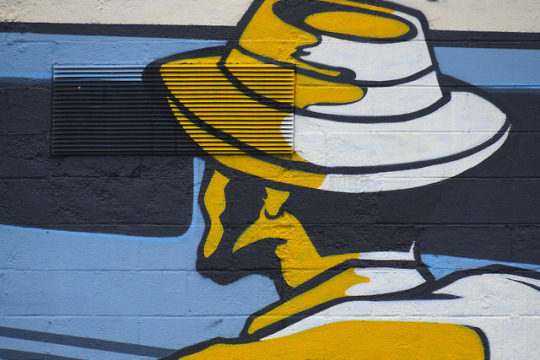

April 5, 2019
“TRAVELING MUSICIAN"
by SEVEN
After becoming an extended production number in the 1941 film “Sun Valley Serenade,” Glenn Miller's “Chattanooga Choo Choo” spent nine weeks at number one on the @Billboard chart and was the first recording ever to be awarded a gold record. 32 years later Chattanooga's Terminal Station was saved from the wrecking ball and transformed into the @ChattanoogaChooChooHotel offering guests the opportunity to stay in unique Pullman train cars as well as traditional hotel rooms. In 2016, on a Rossville Ave wall behind the hotel, local muralist, illustrator, and designer SEVEN—creator/curator of @Burnin_Bridges_Chattanooga street art project—reminisced about the golden age of train travel that played an important role for generations of musicians and served as inspiration for an important chapter of the American songbook. @theartistseven
#art#streetart#urbanart#publicart#mural#TheArtistSeven#ChattanoogaChooChoo#ChattanoogaStreetArt#ChattanoogaMurals
14 notes
·
View notes
Text
Our time in Chattanooga (Pt 1)
Friday 17 November We are off up North from Kissimmee through the undulating countryside of Central and Northern Florida and into Georgia again. Raw Cotton Pass some cotton fields on the way, by the side of the I-75, just what we were looking for two years ago with Phillip & Sylvia, as well as big bales of picked cotton. Just for a change, we stop at a Cracker Barrel for lunch which is a first,…
View On WordPress
#Applebee&039;s#Atlanta#Chattanooga#Chattanooga Choo Choo hotel#Cotton#Cracker Barrel#Engine 4501#Georgia#Holiday Inn Express Chattanooga#Isle of Man Bank#Macon#St George in Utah#Tennessee Valley Railroad#The Hot Chocolatier#Westgate#Wingate by Wyndham
0 notes
Text
Day Two
A beautiful, sunny day greeted our group as we enjoyed breakfast at the hotel, loaded the buses and headed to Chattanooga. Upon arrival, we boarded the Incline Railway and ascended Lookout Mountain as we watched Chattanooga and the Tennessee Valley unfold below us. In operation since 1895, the Incline Railway travels around 10 mph with a 72.7% grade near the top - which some of us found fascinating and some of us found terrifying (you know who you are). After reaching the top and enjoying the views from the observation deck, it was just a short walk down the street (and past beautiful historic homes) to Point Park and the Chickamauga and Chattanooga National Military Park. A helpful park ranger offered to start his daily program early for us, so we were able to hear about the history of the park and the Civil War battles that were fought atop the mountain and in the surrounding areas. We also learned that while the slogan of "see seven states" from the top of Lookout Mountain still exists, you can really only see four (Tennessee, Alabama, Georgia, & North Carolina). Thanks to the clear day, we actually broke the LCC curse of zero visibility from high elevations, and were treated to views of the Blue Ridge Mountains (which we'll be traveling through on day nine).
After descending the mountain (and buying a few slabs of fudge at the gift shop), we headed to the Tennessee Aquarium, where LCC alumni Mindy Price Herman (and 2 of her 3 kids) was waiting to greet us. (Mindy - who participated in our 1997, 1999, & 2001 tours - and her family now live close to Chattanooga where she teaches kindergarten, directs her church choir, and sings with Christian music performer, David Phelps.) After catching up with Mindy and enjoying our chicken finger boxed lunches, we set off to explore the aquarium.
Stingrays and sturgeon and snakes (oh my!) - those were the creatures that we were able to touch in some of the exhibits, along with the countless fish, turtles, otters, gators, butterflies, jellyfish, and one very photogenic white egret we observed on our enjoyable trip through the River Journey & Ocean Journey buildings. After our two hour visit, it was time to continue our journey south to Atlanta (and for those of you on the Hawaii Tour who are wondering if we saw our friends from the Chattanooga choir while visiting their city........we did not. Choo. Choo.)
Upon arriving at our Atlanta area hotel, we checked in, had a quick bite of pizza, salads, & cookies (big thanks to our chaperone clean-up crew), changed into our concert outfits and headed to the Northbrook United Methodist Church in Roswell, Georgia where we just made it into the church before it started to pour. Luckily, the rain did not deter the large crowd that came to hear us perform. Along with our own performance, the Northbrook UMC choir also sang and we were able to join them on the final piece of the night. We appreciated the tremendous hospitality of everyone at the church and were grateful to their staff for agreeing to host the concert (which, in our unbiased opinion, was pretty phenomenal).
The rain had ended by the time we left the church, so we headed back to the hotel for a few minutes of relaxation before putting an end to tour day two.

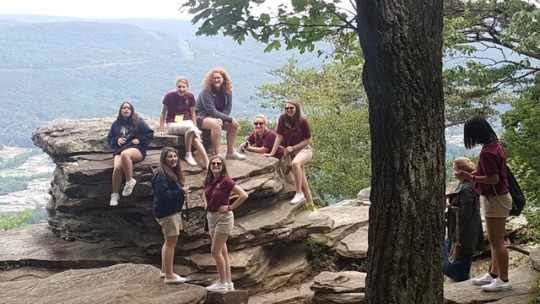
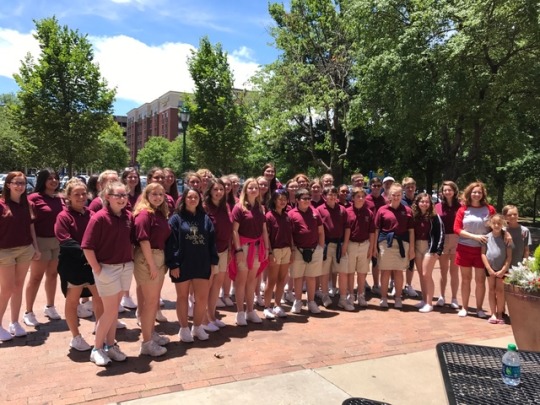

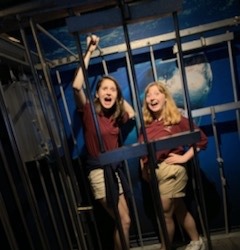
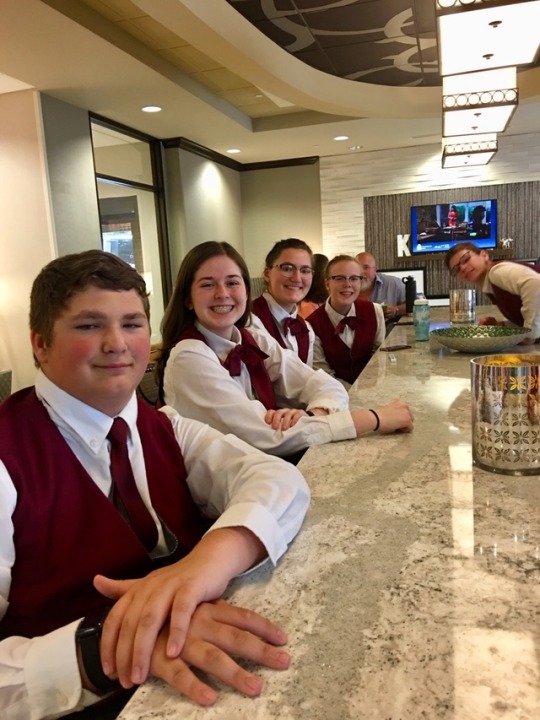
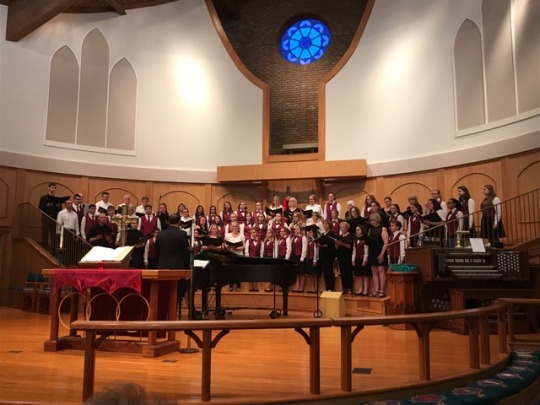
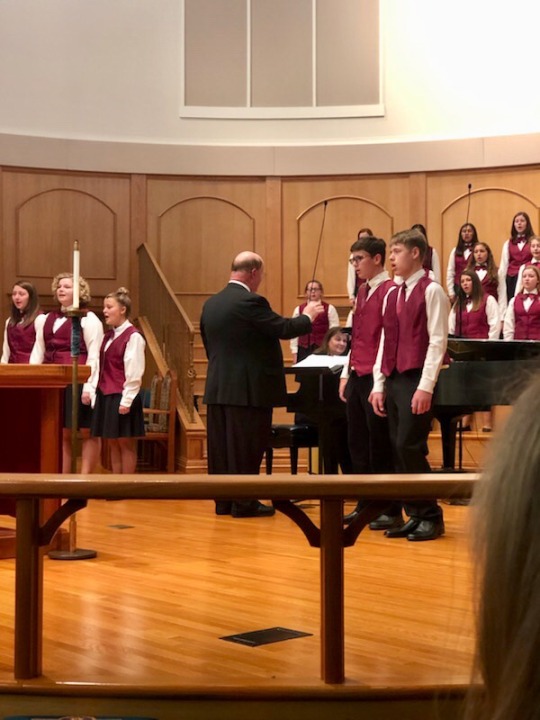
Off to Savannah for day three!!
2 notes
·
View notes
Text
On the subject of winter clothing and what types of fabric to wear...
I was reminded earlier of the joy I had of being one of the Special Guest Writers at Chattacon, the last weekend of January 2014. They flew me out to Chattanooga, Tennessee (big thrill, never been asked to be a special guest before!), and showed me around (the hotel is the former train station of the famous old song Chattanooga Choo-Choo; you could literally stay in a traincar revamped to be a hotel room, if you want!), and it was just a lovely site.
It was also an unusually cold weekend, with the temperature dipping down on Friday night to just 7F (almost -14C) at around 7pm.
I know, because I checked the weather for the area on my laptop after I’d dressed up for the opening ceremonies...and realized I didn’t exactly have something that could go over my outfit for the walk from the building my hotel room was in (I didn’t opt for a half-a-train-car room) across the parking area to the building where the ceremonies were taking place. But it wasn’t too far, and I used to ice skate, so I decided to just wrap up in my pallu and cross the parking lot anyway.
Wait, what...? “Jean...what’s a pallu??”
It’s the fancifully decorated tail end of the sari that gets thrown over your shoulder. Yes, I wore a sari. It was the fanciest thing I owned that was glamorous and feminine at the time. (I actually have like 14 or 17 saris, or something, I’ve lost count.)
Why a sari? Because a friend from the Gujarat state in India (basically, the westernmost corner of the diamond-shaped nation) gave me my first sari, and when I asked her if it was okay for me, a white gal, to wear a sari...and a fat one at that...she told me that sari is the one garment that flatters all figures, and makes all women look beautiful...so if I ever wanted to look beautiful, I should wear a sari. And then she taught me several variations on how to wear it and wrap it, how to shade myself against the heat of the sun and wrap up against the cold of winter, gave me a lecture on how it must never be stitched, and technically shouldn’t be pinned...but sometimes you just have to make it stick to the choli (the top, aka cropped shirt) so your arms can be free to do things, how to wrap it so you can wear it like trousers (it has to be extra wide and extra long), so on and so forth.
The sari I brought to Chattacon was a lovely cream and emerald green silk with high quality faux golden thread accents. And not fake silk, but genuine spit-from-a-mulberry-leaf-eating-caterpillar’s-mouth silk. I had on bike shorts under the sari (to keep my thighs from chafing) a short choli top in a similar shade of green, the sari, and sandals...because I didn’t realize my hotel room and the room where the welcoming ceremony would be would literally be across a frikkin’ cold parking lot. (My fault for not double-checking before I packed, lol.)
...But you know what? I wrapped the pallu around my shoulders and head...and I was fine. The silk was a medium-weight, very tightly woven, and protected me against the evening breeze. It also trapped the air heated by my own body close to my skin. So long as I held the pallu loosely (that’s the key part) around my head and shoulders, I got the insulation benefits of body-heated air.
If I had pulled the pallu up tight against my shoulders and head, however...I’d have felt very cold, because that would mean my body heat was being conducted right through the silk and into the outside air beyond, where my own movements whisked it out of self-heating range. But I knew better. I kept it loosely wrapped, and I astounded the other con attendees who asked me if I was cold, and I said I was not. (Remember, end of January, 7F / -14C degrees!)
Silk--real silk, especially when it’s been tightly woven--is actually a pretty good air barrier. It holds in the air your body heats up, and that is what helps to keep you warm, preventing loss of heat from convection or conduction. (It might also have some minor reflectivity/radiation/retention ability, but I don’t know, so I can’t say for sure.)
Depending upon your personal situation (weather, temperature, wind, precipitation, layering, duration of how long you’ll be out in the cold), silk can actually be a good part of a winter clothing system.
For me, I was literally just crossing a parking lot twice (to get there, then to return) and it was probably half a football field in length. I definitely would not have gone out in the sari if I’d had to walk half a mile (I’m not stupid) but for a short trip, it was fine.
Which brings me to a different point. Yes, silk can be quite good at trapping air, and air is what gives insulation its ability to, well, insulate. But when the temperature drpos below freezing...whatever keeps you warm is the most fashionable thing.
I want to repeat that:
The Most Fashionable Thing To Wear When It’s Freezing Out iS WHATEVER KEEPS YOU THE WARMEST.
So don’t necessarily repeat my trick with the sari. It’s possible, it can be done (and for me, I suppose it helped that I did go through puberty in a skimpy ice skating leotard/dress thing with nylons at most, so my body went into, “Oh, time to burn fat for exercising!” mode)...but don’t get hung up on looking “cute” when the weather pulls a polar vortex.
Focus on looking WARM when you’re suffering a polar vortex.
(Frostbite ain’t sexy.)
(Btw, that exact same silk sari was used the previous summer to keep me cool in 92F / 33C heat at a medieval event, by pulling the pallu up over my head and draping it loosely...because it separated the sunlight beating down on my body from the air underneath the shade of the fabric.)
(Also, cool fact: the sari is the only garment in all of recorded history (statuary, carvings, paintings, etc, count) that has been continuously in fashion for over 5,000 years. It has been continuously worn without pause for five thousand years, in one wrapped iteration or another, across the Indian subcontinent. So if you’re going to wear a sari, wear it with respect for all those five thousand years’ worth of history...and by all means, wear it to make yourself look gorgeous!)
5 notes
·
View notes
Text
Luther’s legacy: How people use the Bible today, 500 years after a monk sparked the Protestant Reformation
G. Jeffrey Macdonald, CS Monitor, October 29, 2017
CHATTANOOGA, TENN.--Students at Ooltewah High School in suburban Chattanooga are still yawning at their desks at 7:20 on a recent morning when teacher Daniel Ziegenmier says something designed to awaken their consciences.
“OK,” he announces, “time to put away your phones. Everyone come forward and get a Bible.”
Soon their minds are back in Old Testament times with help from a six-minute video summarizing Genesis.
For sophomore Jackson Clark, the material isn’t new. He’s already learned it in church. But he says he appreciates engaging with the Bible in a neutral setting, one with no religious agenda and no expectations about what to believe or how to interpret it. And he’s glad private donors give money ($1.3 million this year) to fund elective courses in Bible history for more than 3,700 of his fellow Hamilton County public school students.
“Even if you don’t have access to a church, it’s good to know about [the Bible] and be able to ... enjoy it,” Jackson says. “By taking this at school, they still get all the basic knowledge that you’d get out of church, all the stories and lessons that you get from reading the book.”
Bible courses are relatively rare in American public schools, where boards, including Hamilton County’s, try to avoid any whiff of religious endorsement or breach of the church-state divide. But here in the buckle of the Bible Belt, their growth is an example of efforts to foster reading the Bible--a practice that is a central legacy of the Protestant Reformation that was launched 500 years ago this month.
From Chattanooga to Johannesburg, in churches, schools, and living rooms, the reform movement fomented by an iconoclastic monk named Martin Luther has shaped how millions of people around the world seek God. Now, in the age of the internet, shifting cultural mores, and falling church attendance, the role of the Bible is evolving again.
In some Western countries, Bible use is in decline. In other regions, it is on the rise--and the internet promises to expand its reach even more. But how people actually interact with the Bible--whether they consider it the supreme authority on questions of faith, as Luther decreed it should be--is changing, too.
Perhaps nowhere are Luther’s legacy and the various ways the book is affecting everyday life more evident than here in Chattanooga, Tenn., the Appalachian city where public monuments quote Scripture and honor devout churchmen who helped make it the unofficial Bible capital of the world.
The man who rocked Christendom 500 years ago and made Bible reading a spiritual staple was among the least likely of revolutionaries. A miner’s son who harbored early ambitions to practice law, Luther turned to monastic life in a moment of panic: He promised during a violent thunderstorm to become a monk should God mercifully spare his life.
Luther fulfilled his vow, but Augustinian monkhood for him would soon involve much more than the usual prayer and fasting. His study of ancient biblical languages would open the floodgates of Protestantism.
At age 33, Luther hammered a fateful nail into the Roman Catholic Church--figuratively, and, according to popular legend, literally--when he posted his 95 Theses on the church door at Wittenberg Castle in Germany on Oct. 31, 1517. The pope’s selling of indulgences to those hoping to get deceased relatives out of purgatory had no biblical basis, Luther argued. He dismissed the practice of paying money to be absolved of sin as a corrupt, human invention rather than divine truth, even if the pope sanctioned it.
Luther’s core ideas--that humans reach salvation by grace through God-given faith, not their deeds, and that the Bible is the central religious authority--had been embraced by prior reformers. But the contentious, moon-faced monk crystallized them at a time when excesses and corruption made the Catholic Church susceptible to change.
As a result, the Protestant Reformation eventually swept the West, aided by new technology. The new printing press with movable type made publishing exponentially more efficient, starting with the Gutenberg Bible in the mid-15th century. Luther and others translated the Bible from Hebrew and Greek into local vernaculars.
“When the people could read the Bible for themselves ... in a language that they could understand, that’s what really caused the spiritual explosion of the Reformation,” says Jim Thompson, vice president of Bible League International, a Bible distribution organization based in Crete, Ill.
Since then, Protestants have been defined by the principle of sola scriptura, which holds that while other sources might deliver insights, the Bible is the supreme guide on questions of faith. And every human being should engage directly in what it has to say.
“At the end of the day, sola scriptura was the trump card,” says Thomas “Tal” Howard, professor of humanities at Valparaiso University in Indiana and co-editor of the book “Protestantism After 500 Years.”
“Christians reading the Bible on a daily basis--that didn’t really go on before the Reformation, or only to a limited extent,” notes Kathleen Crowther, a Reformation historian at the University of Oklahoma in Norman.
Today Protestants still embrace sola scriptura as an ideal. Forty-six percent of Protestants in the United States say the Bible provides all the religious guidance they need, according to a 2017 Pew Research Center survey. Another 52 percent say they also need guidance from church teachings and traditions, which is consistent with the early Reformers’ view as long as the Bible has the final say, says Mr. Howard.
But in practice, Americans are spending less time with the Bible and ascribing less authority to it than they used to. The percentage saying they read it at least weekly dropped from 46 percent in 2009 to 37 percent in 2017, according to the Barna Group, a Christian polling firm in Ventura, Calif.
“We have a growing biblical literacy problem in the US,” Mr. Thompson says.
Perceptions of biblical authority have been waning, too. Led by Millennials, 19 percent of Americans now view the Bible as “just another book” rather than an inspired text, up from 10 percent in 2011. The internet accounts for at least some of the Bible’s lost stature.
“What’s increased, especially with Millennials, is this questioning of authority in all places,” not just the Bible, says Roxanne Stone, Barna’s editor in chief. “It can be hard to have this sense of the Bible being an authority when you have a universe of knowledge at your fingertips.”
Overseas, proponents of direct Bible engagement face distinct challenges. In Europe, where the Reformation began, only 28 percent of the literate population owns a print version of at least one book of the Bible, according to data from the Center for the Study of Global Christianity at Gordon-Conwell Theological Seminary in Hamilton, Mass. Bible access ranks the highest in North America, at 95 percent, but it stands at only 16 percent in Asia and 29 percent worldwide.
One place where there isn’t a dearth of Bibles is Chattanooga. Here, in a city nestled between forested hills and a sweeping bend in the Tennessee River, 50 percent of the population reads the Bible at least weekly and strongly regards it as accurate in its principles, according to a 2017 Barna survey. As a result, the polling firm anointed Chattanooga America’s “most Bible-minded city,” which, given the book’s prevalence in North America, means it is probably the No. 1 city in the world for the holy book.
How that happened is a function of history and culture. Chattanooga is more traditional and pragmatic than it is flashy or trendy. Crafts are handed down to younger generations at places such as the Chattanooga Woodworking Academy. A manufacturing culture remains deeply embedded here: Workers on assembly lines bottle Coca-Cola, make cardboard food trays, and build Volkswagens, though the city also has an emerging high-tech scene. Signs point visitors to local history at every turn: Civil War battle markers, the infamous Trail of Tears, and the Chattanooga Choo Choo, a depot-turned-hotel and exhibit.
Faith and family run deep in this tradition-heavy culture. The area is home to dozens of churches, as well as many other major religious institutions, including five Christian colleges, Precept Ministries International, and the world headquarters of The Church of God (in nearby Cleveland, Tenn.).
But even here, sustaining Luther’s vision of sola scriptura requires new creativity. This is evident on a Sunday morning at Chattanooga’s Trinity Lutheran Church. The first thing you see--after a cheery mural depicting Luther and his wife, Katharina--is a smorgasbord of Bible study groups.
In the church’s library, retired religion scholar Herb Burhenn unpacks John 16 verse by verse as a dozen seniors seated around a long table listen and nod deferentially. Down the hall, Mike Brandt leads a second group of adults in a more casual format. In a dining area, kids and adults cluster around small tables, where each offers an interpretation of Jesus’ teaching on reconciliation in Matthew 18.
Trinity offers multiple approaches to Bible study, according to the Rev. Stan Combs, because the path to experiencing the Bible’s authority varies so much in 2017 from one person to the next. That’s especially true in this era when countless experts and potential authorities--whether in religion, politics, or science--are always as close as the click of a mouse.
For some teens at Trinity, the Bible’s decrees are to be embraced no matter how much they go against popular culture. Fourteen-year-old Sam Sosebee, for one, believes his denomination, the Evangelical Lutheran Church in America, needs to hew more closely to Scripture. “The Lutheran church lets gays be pastors, but that’s one thing I’m conflicted about because the Bible says you shouldn’t,” he says.
His 16-year-old sister, Abby, welcomes how the Bible challenges her group of friends to lead holy lives, such as by shunning the gossip that typically marks teenage social life. This fall, they’ve made the Bible their hardcore trainer for a spiritual fitness regimen that involves reading all 66 books in 90 days.
“It’s always been present in my life, but going and reading it myself has made it so much more real,” says Abby, still wearing her white vestments after reading the day’s Scriptures in worship. “It’s made me so much more passionate to just get it out there for other people to know about.”
Beyond Tennessee, the quest to encourage direct Bible engagement stretches across the globe as the Reformation enters its sixth century. It remains a hallmark of global Protestantism, which counts 800 million adherents after a surge of overseas mission activity in the 19th and 20th centuries.
Today, Protestantism’s center of gravity has shifted from Europe and North America to the Southern Hemisphere. A plurality of the Protestant faithful (295 million) lives in sub-Saharan Africa.
But those following in the Reformers’ footsteps abroad face distinct challenges to the sola scriptura method. Lack of access to the Bible remains a significant problem. Some 160 million people don’t have even one book of the Bible available in their language, according to Bob Creson, president of Wycliffe Bible Translators, a nonprofit based in Orlando, Fla. Technology, as in the 16th century, is helping. Translation software has cut the average time for translating the New Testament into a new language from 25 years to seven. By 2033, every person will be able to find at least one biblical book in his or her language, according to Mr. Creson.
Distribution remains a problem, too. Bibles often pile up in churches, never reaching people in remote locations. But believers are making inroads by using the Bible primarily as a tool for evangelism in countries such as Mexico, Ghana, Kenya, and the Philippines, according to Thompson of Bible League International.
Disseminating print versions remains important even in the Digital Age. That’s in part because more than half the world’s population still lacks internet access. Even where web usage is the norm, Bible readers prefer print versions by a large margin: 81 percent in the US opt for print over digital for Bible reading, according to Barna’s 2016 “The Bible in America” report.
Nevertheless, Bible distributors hope the web will soon usher in the highest level of Bible engagement in history. “Some people are calling digital the second Gutenberg,” says Thompson. “I think it one day will be.”
In Chattanooga, some view the Bible as a way to help improve morality among young people. The Bible in the Schools program is founded on the premise that Bible study “diminishes dishonesty, lying, profanity, and bullying” and otherwise improves moral character. (It avoids legal challenges over church-state separation by not promoting any religion, doctrine, or interpretation.)
Still, studying the Bible has been no moral panacea for Chattanooga schools. In two reports on bullying over the past year, the Office of District Attorney General Neal Pinkston identified 122 incidents, called out a hazing culture on sports teams, and flagged “widespread, systemic problems going unaddressed at every level within Hamilton County’s public schools.”
But proponents of direct encounters with the Bible believe it can still have an edifying effect, even with all the countervailing forces in modern society. Some are convinced that the best way forward--for young and old alike--is to rely on traditional methods that worked in generations past.
“I still have the faith of a child,” says Eleonore Williams, a lifelong Chattanooga resident and member of Trinity Lutheran, who is 94. “A child is open to believe and accept.”
A retired accountant and avid hiker of the Great Smoky Mountains, Ms. Williams reads the Bible for 30 minutes daily after breakfast. In encouraging others to trust the holy book, she’s helped at least three people who were suicidal to find hope in God’s promises. “They have to read the Scriptures and believe them, not read them and be tearing them apart,” Williams says.
Even though busy lifestyles and numerous daily distractions keep many people from reading the Bible today, there are signs of growing interest in the Scriptures. A new Museum of the Bible will open in November in Washington, D.C. A children’s Bible museum, Trek Thru Truth, which will use interactive exhibits to tell 52 Bible stories, is planned for Cleveland, Tenn.
On this year’s 16th anniversary of the 9/11 terror attacks, about 300 people gathered at another site in Cleveland, the Peerless Road Church. Prayers focused on spiritually uplifting the mass media industry, which 33 percent of Americans blame for the nation’s moral decline. For 2-1/2 hours, singers, dancers, artists, and writers called for a national return to God--and the Bible.
“Take me to the place where a miracle is needed,” cried LaEsha Williams, a fiction writer from Rossville, Ga., before the arm-waving crowd. “Take me to the place of deepest darkness. Let me give light that was given to me.”
Luther, no doubt, would say, “Amen.”
1 note
·
View note
Text
The Best Part of a Baseball Trip is the Planning
Next stop, Nashville.
Those are the words I can already hear myself saying as my 11-year-old daughter and I sit in front of the computer, mapping out something of a dream vacation. It'll just be the two of us, giving us some great windshield time, just talking as I drive us from one minor league baseball park to the next.
It's a trip we've been talking about for a couple years and we just decided to sit down and actually put pen and paper to the notion, to bring it to life. This, of course, will make us accountable: me to her to actually follow through with the trip and both of us to the rest of our family ... to actually follow through with the trip.
We're beginning at the home base here in central Arkansas. We're planning to leave early Sunday afternoon, in time to catch a 2 p.m. start of a Memphis Redbirds game at their still-seems-new AutoZone Park. From there we'll head south into Alabama and catch the Huntsville Stars on Monday night at Joe W. Davis Municipal Stadium, then head to Chattanooga's BellSouth Park to see the Lookouts in action on Tuesday night. Wednesday night will find us in Nashville, watching the Sounds do battle at Greer Stadium.

On Thursday, we'll head to Jackson, Tenn., for a West Tenn Diamond Jaxx game that night. After the game, we'll drive the three hours on home. If we're feeling really ambitious, we might just head on into Little Rock for an Arkansas Travelers game. Probably not, though, as we can catch the Travs just about anytime.
So, that's the plan. Five games in five days, which probably doesn't strike the die-hard as the end-all, be-all baseball dream trip. For us, though, it's more about the time spent together in a car that's starting to smell and could probably use an oil change. It's about bunking with whatever friends we happen to have along the way and it's about eating ballpark franks at each and every ballpark we visit.
And, for her, it's about the souvenirs.
The tricky part is that the budget for this trip isn't exactly astronomical. Part of the reason is that we relish the challenge of making the trip on as little money as possible. The bigger part of the reason is that my wife doesn't want us spending much money on the trip. So, how are we going to do it?
We have friends just outside Memphis that we'll be staying with after the Redbirds' game, which will save a night of hotel charges. We'll pay for gas and something to eat at the park, something that would cost about half as much if purchased beforehand, of course. If we have friends in Huntsville, we've forgotten about them, so an adjustment is needed there. It's only 120 miles on to Chattanooga, though, which means it's worth it to drive the two hours after the game for a free place to sleep in Chattanooga.
That also means we can sleep late since we're already in our next host city. Perhaps there will be time to visit some of Chattanooga's attractions, like the Choo Choo, Rock City or the Tennessee Aquarium.

After spending another night in Chattanooga, we'll make the easy (two-hour) trek to middle Tennessee, where we'll spend the night with more friends and take in the Nashville Sounds game. The roughest part of the journey, we figure, will be after Thursday night's game in Jackson, Tenn., which involves the aforementioned three-hour drive.
Friday will be a day for rest. And, yes, possibly, the Travelers' game.
The tricky part of all this, besides keeping the cost down, is matching up all the appropriate teams' schedules to fit your own. If you have five teams involved - as we do - odds are there are only a couple times during the course of a minor-league season when it would be possible to catch every team at home - on the nights you need them there.
Then again, the planning is usually the best part.
0 notes
Photo
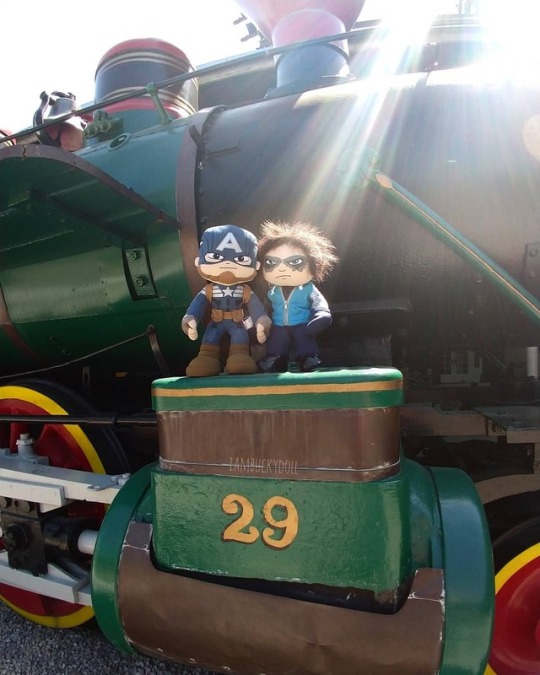
#tbt to Engine 29 in Chattanooga with SteveDoll and me 🚂 . . . #stevedoll #bff #throwbackthursday #chattanooga #tennessee #chattanoogachoochoo #train #buckydoll #buckybarnes #wintersoldier #sebastianstan #whitewolf #marvel #avengers #captainamerica #toyphoto #toyphotography #toysofinstagram (at Chattanooga Choo Choo Historic Hotel) https://www.instagram.com/p/BrViUpUHU9N/?utm_source=ig_tumblr_share&igshid=1bvboldf5z7y8
#tbt#stevedoll#bff#throwbackthursday#chattanooga#tennessee#chattanoogachoochoo#train#buckydoll#buckybarnes#wintersoldier#sebastianstan#whitewolf#marvel#avengers#captainamerica#toyphoto#toyphotography#toysofinstagram
2 notes
·
View notes
Text
Chattanooga
One of my first friends in residency was Jenny Rosen, who defended my pride when senior residents were disappointed in my mistakes and kept us both laughing when it felt like, as she put it, we were swimming through the hospital, wading bleary eyed and sleep deprived to find our way from one far reaching annex to another as our 24 hour calls came to a close.
In September of 2018, she graciously invited me to her hometown of Chattanooga, where we stole away from the first three months of residency and remembered midday icecream, sleeping in, and walks along the water stung by jets of sunlight.

State of Confusion
Part of downtown’s Southside at E Main and Passenger. There’s a lot of outdoor seating, and the margaritas are fantastic. I also got the Confusion Salad, which was delicious. It used to be a salvage yard called Estate of Confusion - a lot of the art that is used to decorate the restaurant looks almost steampunk. The nachos are great late night food (basically potato chips with delicious queso). Plenty of parking.
Community Pie
Cute bar with lots of eclectic, mechanical chandeliers behind the bar. Great for New York pizza, salad, pasta. Part of the Monen Family restaurant group, which includes Milk & Honey (homemade gelato). There’s actually a Milk & Honey Coffee Bar in Community Pie - with coffee, gelato, and breakfast items.

Poblano’s
Super cheap brunch - my chilequiles were $8. $2 double mimosas. $3 sangria all day on Sunday. Covered outdoor seating, not super crowded. Their chips are perfect with queso.
Tivoli theater
We saw Aziz Ansari debut new material for $50 at the Tivoli - there are a lot of big artists that come through all the time for comedy, country, rock, Broadway, etc. It opened in 1921 and still has the original box office. The chairs are kind of small but are beautiful red velvet plush. The lobby is gorgeous, with crystal chandeliers and a white floor inlaid with green marble.
Sculpture Garden
The art museum (which isn’t free… so we walked around the sculpture garden instead) is right on the river, across from the Aquarium (which has beautiful glass pyramids housing the butterfly gardens atop the building). It’s a fun and engaging walk through the sculpture garden, including work by Deborah Butterfield and George Segal.
Chattanooga Shoe Company
I didn’t get to do any shopping in Chattanooga, but my friend had a pair of shoes from this shoe company that was fantastic - so I looked it up and hope you get to go shopping here for me!
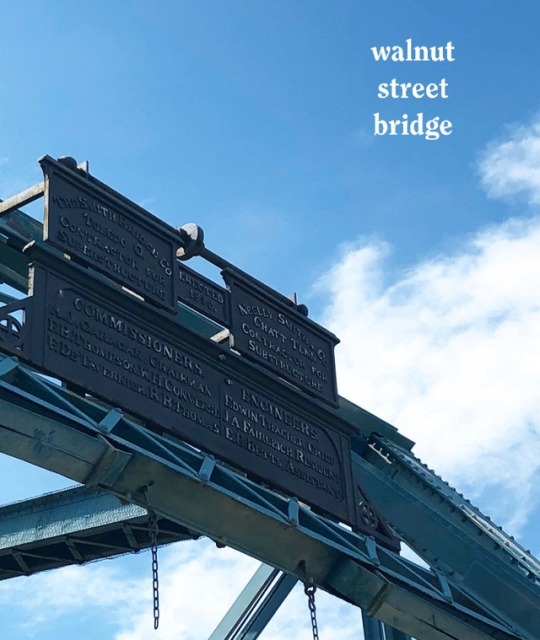
Walnut Street Bridge
Pedestrian walking bridge that’s part of the Seven Bridges marathon (October), goes across the Tennessee River. There’s events like Wine over Water and Riverbend Festival too.
WHERE TO STAY
We stayed with Jenny’s high school friends Emma and Alex at the base of Lookout mountain, which is the old money mountain. The other mountain a lot of people live on is Signal mountain, which is more new money. There’s a ride to the top of Lookout, which was the site of an important win for the Union in 1863.
CHOO CHOO
It was registered as a historic site in 1974 after being saved from demolition by local businessmen. The train became famous after the Glenn Miller Orchestra performed this song that was featured in the movie ‘Sun Valley Serenade’. There’s also a Songbirds guitar museum that has two stages attached with lots of live shows.
EDWIN HOTEL
Still under construction, but will hopefully be built up by the time you go. Also on the river, it has a rooftop bar and very cute restaurant (Whitebird) on the first level featuring seasonal dishes that source locally.
0 notes
Photo






Chattanooga, TN: The Chattanooga Choo Choo 3
We’ve still got a couple of other photosets to go before I’m even done exploring this hotel. In the meantime, take a look at some of the sights and passenger cars/rooms outside the lobby area. I see exactly why someone would want to stay here, though this wasn’t my hotel for the trip.
3 notes
·
View notes
Photo



Some more of our specials at the foaming primate
0 notes